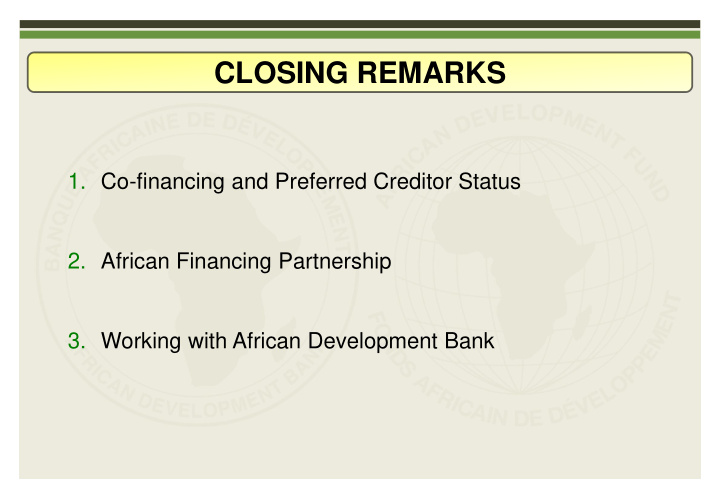



CLOSING REMARKS 1. Co-financing and Preferred Creditor Status 2. African Financing Partnership 3. Working with African Development Bank
A/B LOAN STRUCTURE AfDB acts as Lender-of-Record Keeps part of the loan for its own book (the A-loan) Sells participations to commercial investors (the B-loan) Tried and tested technology (mirrors EBRD / IFC structures) B-loan participants take exposure to the underlying project credit risk A and B loans may have different maturities with consistent pricing Debt servicing is centralized in a facility “agent” B-lenders can be bank or non-bank Over the life of the B-loan, the A-loan must always be at least 25% of the total B- lenders benefit from ADB’s preferred creditor status
A/B LOANS Preferred Creditor Status – mitigants to political risk: Official • Currency conversion / remittance of interest • Immunity from sovereign rescheduling • Exemption from withholding tax Unofficial • Deterrent effect: nationalisation, interference
A/B LOANS Benefits to B-lenders: 1. Under Basle II (Standardized approach), B-lenders may rate facilities as local currency obligations; 2. Under Advanced Internal Ratings approach, lenders may reflect country risk mitigation in country risk weighting 3. B-loans may be combined with commercial political risk insurance. Preferred creditor status is reflected in premium rates.
A/B LOANS B-Loan Participant Eligibility: Viable and commercially operated financial institutions – bank and non-bank Institutions NOT eligible: Banks incorporated or with head office in the country where the borrower is – incorporated or the project is located Export credit agencies – Governmental, quasi-governmental, or multilateral agencies – Project sponsors and off-takers – Eligible participants require an investment grade rating AfDB may accept lower-rated or unrated participants –
THE AFRICAN FINANCING PARTNERSHIP African Development Bank Development Bank of Southern Africa DEG European Investment Bank FMO Industrial Development Corporation IFC Proparco
THE AFRICAN FINANCING PARTNERSHIP Origins and Rationale Formed during the financial crisis Need for DFIs in Africa to improve operating efficiency and to reduce the burden on clients Serves as a means of harmonisation, standardisation and best practice
THE AFRICAN FINANCING PARTNERSHIP Focus on large scale infrastructure and industries projects, but: Innovative smaller projects / financial services / public-private partnerships may be considered. Some diversification in criteria Definition of private sector – IFC Geography – DBSA / SADEC Operational Guidelines Possible future partners
WORKING WITH AFRICAN DEVELOPMENT BANK Timing: Lead times of approvals v. Lead time of projects Special considerations: Additionality Environmental and Social Impact Development impact Focus: project first, then loan Partner rather than lender of last resort
FIRST B-LOAN Transnet Ltd., RSA A-loan: US$400 million + B-loan: US$410 million A-loan: 10 years / 2 grace + B-loan: 7 years, 2 grace SMBC (Agent), Bank of China, Mizuho, BTMU, HSBC Signed October 2011
RECOGNITION Infrastructure Journal, April 2012: MLA of The Year – Power Multilateral of The Year.
Recommend
More recommend